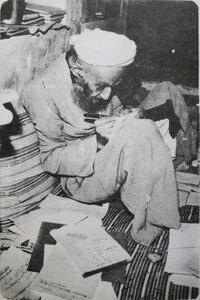1/Millions of Shiʿi Muslims around the world will be celebrating what they consider the appointment and designation of ʿAlī b. Abī Ṭālib as the legitimate successor to the Prophet Muḥammad. A short thread on #EidGhadir. 

2/The "investiture" of ʿAlī according to the Shiʿi sources took place on 18 Dhu l-Ḥijjah in 10 H (= March 632 AD) at a pond between Mecca and Medina, known as Ghadīr Khumm. What do they sources say happened exactly? 

3/Medieval sources differ little in the wording and historical memory of the events at Ghadīt Khumm in 632 AD, which came shortly after Muḥammad's Farewell Sermon. The formulaic wording is common to all the medieval sources. It reads: من كنت مولاه فعلي مولاه
4/The formulation, translated into English, reads, “O people! Of whomsoever I am a master, Ali is his master. Am I not closer to you than your own selves?” 



5/Appearing in proto-Sunni/Sunni and Shiʿi sources the formulaic words attributed to Muḥammad is a contested on theological and philological grounds. The Sunni view is best represented by the thirteenth century historian and exegete Ibn Kathīr (d. 1373).
6/Ibn Kathīr rejects the Shiʿi claim that Ghadīr was an investiture of ʿAlī as Muḥammad's successor. He explains that his predecessor al-Ṭabarī writing in the tenth century AD tackled the event of Ghadīr dealing with its historicity and theological implication 



7/Put simply, Ghadīr was little more than an attempt by Muḥammad to pacify some companion who became especially angry with ʿAlī during the campaign at the Yemen, complaining that ʿAlī acted unfairly and greedily when distributing the booty
8/The Shiʿi reading of the events at Ghadīr disagrees. According to standard Shiʿi narrative the episode was an investiture where Muḥammad appointed his legatee, namely ʿAlī. We read in the Shiʿi sources - exegetical & historical - that Quran 5.3 was revealed shortly after.
9/That is, when Muḥammad designated ʿAlī as his successor, the following verses came down, according to Shiʿi and a small minority of Sunni exegetes: "This day I have perfected for you your religion and completed My favor upon you and have approved for you Islam as religion 

10/In a clear rejection of the Shiʿi point of view, Ibn Taymiyyah (d. 1328) takes a firm stance, explaining that there is nothing in the ḥadīth [of Ghadīr] to support the Shiʿi claim of investiture. 



11/In response, Shiʿi theologian and historians level the following rebuttals. One, the wording of Muḥammad went beyond intent to assuage anger. The linguistic context of the sermon, they argue, lends credence to an investiture or appointing of legatee.
12/Ibn Muṭahhar al-Ḥillī (d. 1325) in his Minhāj al-karāmah explains that God commanded His prophet to make a proclamation that shall seal the divine favour and complete the revelation. Ḥillī is adamant that Sunni exgetes recognise the occasion of revelation to refer to Ghadīr 



13/We learn from the sources that Muḥammad's now formulaic saying, "whoever I am the mawla of, then ʿAlī too is their mawla," was preceded by reminder where Muḥammad asked the congregation present whether he commands authority over them, using a derivative of the term "mawla" 

14/Second, the Shiʿis maintain that the proclamations at Ghadīr marked a culmination of numerous sayings of Muḥammad hinting or explicitly pointing to ʿAlī's credential as a likely successor. Ḥillī, for example, says there was as much as 40 such references in Quran and ḥadīth. 

15/Third, Shiʿis further argue that the earliest companions and their successors especially the family of Muḥammad saw Ghadīr as an investiture of ʿAlī imamate, or leadership as the successor of Muḥammad.
16/The twentieth-century bibliographer ʿAbd al-Ḥusayn al-Amīnī (d. 1970) compiled the data that includes early views on Ghadīr. He published his findings in an 11-volume compendium consisting of over 5,500 pages, titled الغدير في الكتاب والسنة والأدب 

17/For instance, al-Amīnī recounts incidents in history when prominent companions invoked the incident of Ghadīr to support their claim that ʿAlī was the rightful successor to Muḥammad often during heated theological disputes known as احتجاجات 





18/Medieval sources describe the reception of the Day of Ghadir in Muslim memory. There are accounts from early 10th century AD historians onwards that the day was celebrated in public. 





19/The medieval sources also speak of earlier celebrations to mark the Day of Ghadir, including celebrations held by the Imams, such as al-Riḍā (d. 818), who is reported to have said the Day of Ghadir is a عيد ʿĪd. FIN. 





• • •
Missing some Tweet in this thread? You can try to
force a refresh














